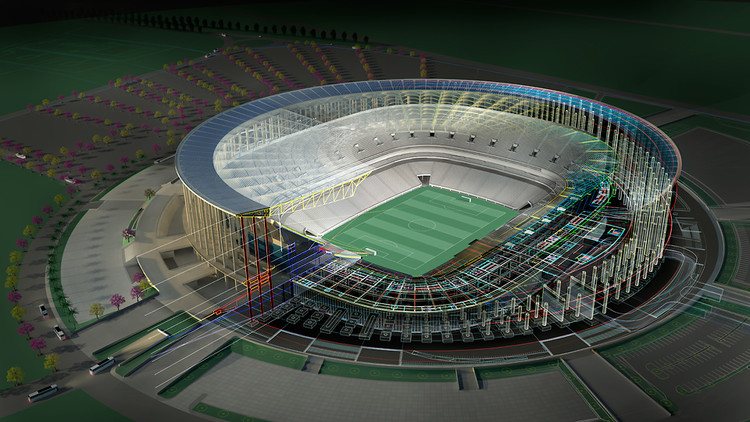
Brazil is about to do double-duty hosting international sporting events--first, the 2014 World Cup and then the 2016 Olympics. That means some serious sports center remodeling is in order. The Estádio Nacional de Brasília, a stadium in the middle of Brazil’s capital (Brasília), is getting the most impressive upgrade, at least in our eyes. When it’s finished, the stadium should reach LEED Platinum certification and become the first net-zero-energy stadium in the world.
The stadium, designed by Castro Mello Architects using Autodesk software, will be the second-largest World Cup stadium in the 2014 games. The remodel (the stadium was formerly known as Estádio Mané Garrincha Stadium) will bring seating capacity up to just over 70,000 seats.
That LEED Platinum status will be achieved through a number of design elements:
- A ring of solar photovoltaic panels on the roof provides the stadium’s power. Because of new net-metering legislation in Brazil, the stadium will be able to trade energy between the panels and the power grid as necessary.
- VIP bicycle parking for 1,000 bikes inside the stadium. There will be 3,500 bike parking spots in total. Ian McKee, the green building and sustainability manager for Castro Mello, says he doesn’t know of any other stadiums with this much bike parking inside.
- A photocatalytic membrane on the roof that captures air pollution as it falls, and breaks down the chemicals, removing them from the atmosphere. This is especially important because over 50% of CO2 emissions related to stadium operations come from transportation to and from the stadium.
- A rainwater collection and recycling system for landscaping use, and low-flow water fixtures inside the stadium.
- Lots of natural light--but ample shading from the hot Brasilia sun as well.
- The new design reuses material from the old stadium.

Castro Mello aims to fix some of the features that traditionally have stopped the elite in the country from going to games at stadiums. "They’re considered unsafe and more of a lower to middle income person activity [in Brazil]. Athletic tracks within the stadium are between the stands and soccer fields, which destroys sight lines," says McKee. Safety fears are warranted; in 2007, seven people died when a stand at the Fonte Nova stadium in Salvador collapsed. The new stadium, in contrast, is built with safety in mind and has a lowered pitch that allows for clear views from all seats.
None of this comes cheap. The stadium is expected to cost more than $400 million to complete. But the solar panels, at least, are expected to provide a return on investment in 10 to 12 years, with the panels themselves able to perform well for at least 25 years.
The Estádio Nacional de Brasília is expected to be completed at the end of the year.
ARIEL SCHWARTZ
Source: co.EXIST http://goo.gl/bXWAA


comment